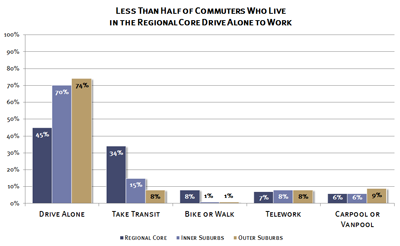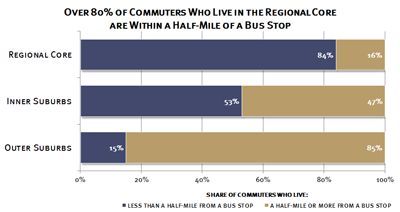The results of the latest "State of the Commute" survey, conducted earlier this year by the Transportation Planning Board's Commuter Connections program, confirm that the travel mode people use to get to and from work each day depends in large part on where they live.
In the region's core jurisdictions, the District of Columbia, Arlington, and Alexandria, less than half of commuters drive alone to work each day, while more than a third take transit, a figure that is twice the regional average. Eight percent of commuters in the core report bicycling or walking to work.
 |
In Montgomery, Prince George's, and Fairfax counties, the region's inner suburban jurisdictions, the share of commuters driving alone increases sharply, to around 70%. The share that takes transit is more than halved, to 15%.
In the outer suburban jurisdictions -- Loudoun, Prince William, Frederick, Charles, and Calvert counties -- 74% of commuters drive alone to work each day, while the transit share is halved again, to 8%. In both the inner and outer suburbs, just 1% of people bike or walk to work, far less than in the regional core.
These results, taken from the TPB's survey of 6,335 randomly selected employed individuals throughout the region, confirm that where one lives plays a big role in the travel mode one is likely to take to get to and from work each day.
The availability of different travel modes is a major factor leading to differences in mode choice in different parts of the region. In areas served by Metro, for example, the share of commuters who regularly take transit is sure to be higher, while in areas without it, transit use will be considerably lower.
But land-use is also a key factor, as development patterns have a lot to do with the availability and success of different travel modes.
According to the "State of the Commute" survey, 84% of commuters living in the regional core -- a more densely developed area -- live within a half-mile of a bus stop. That number falls to 53% in the inner suburban jurisdictions, and to just 15% in the outer suburban jurisdictions.
 |
More densely developed areas like the core tend to have better transit access because they are able to provide the ridership needed to sustain quality service. They also tend to have greater use of bicycling and walking because origins and destinations are usually closer to one another and linked by a well-connected street system with sidewalks, both of which go a long way in making the use of such modes more likely.
One example of this is the Logan Circle neighborhood in the District, where a 2012 TPB survey of neighborhood-level travel patterns found that 44% of commute trips are made by bicycle or on foot -- more than five times the average for the regional core. The same survey found that 5.5% of commute trips in Frederick, Maryland -- with its mixed-use downtown and gridded street system -- are made by bicycle or on foot, compared to the average of 1% for the region's outer suburban jurisdictions. These cases demonstrate the dual importance of land-use patterns and access to transportation alternatives that make it possible for more people to choose options other than driving alone.
The TPB's "State of the Commute" survey has been carried out every three years since 2001 by Commuter Connections, a TPB program that aims to promote alternatives to driving alone, like ridesharing, transit, teleworking, and bicycling and walking. The survey tracks changes in commute patterns, telework participation, and people's perceptions of and satisfaction with their daily commute. That information helps Commuter Connections tailor its outreach efforts and aids the TPB in refining the travel models it uses to predict future travel patterns and assess future air quality.
The "State of the Commute" survey illustrates the important relationship between land-use and transportation: along with encouraging travelers to use modes other than driving alone, we need to make more travel options available to them and shape development patterns in ways that make such options practical.
Related Links